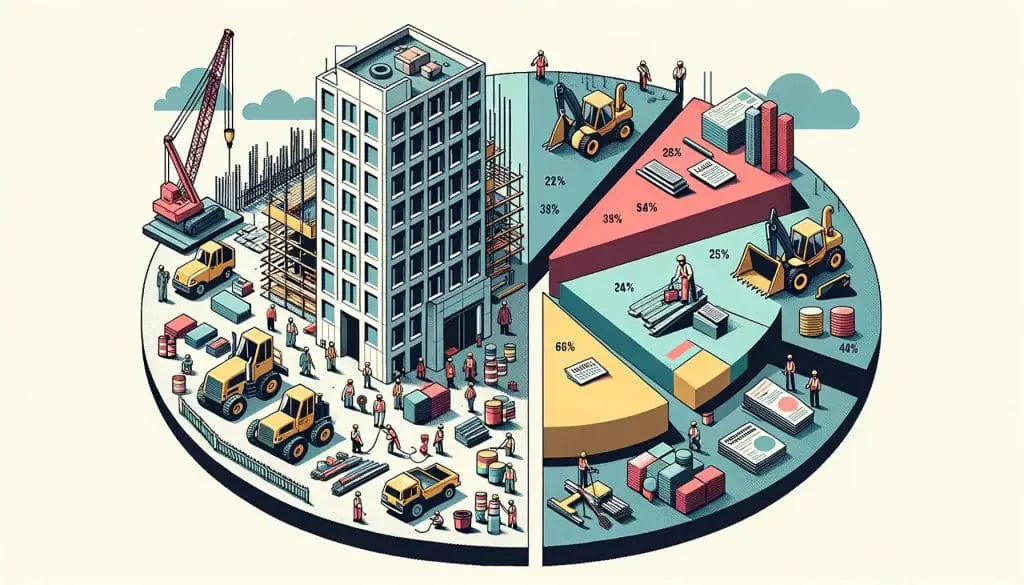Construction budgeting is a crucial component of any construction project. A construction budget is a cost estimate that outlines the anticipated costs and expenses associated with a project – however large or small.
A construction budget helps builders and owners stay on track financially, supports client relationships, and guide decision making from project inception through closeout.
In this blog, we explore the opportunities and challenges presented by construction budgeting and go into detail about how to develop a construction budget (plus pitfalls to avoid).
Table of Contents
Understanding the Basics of Construction Budgeting

Here’s a high-level overview of the basics of construction budgeting and why it’s important.
What is Construction Budgeting?
Construction budgeting is critical to the planning process of any project. Budgeting helps owners and builders understand the scope of the project and associated costs and avoid cost overruns.
Although the terms “construction budget” and “construction project budget” are used interchangeably, they are different:
- A construction budget is an estimate of the overall costs incurred during the physical construction of a building or infrastructure asset. A construction budget includes the cost of lumber, steel, concrete, HVAC, wiring, windows, etc.
- A construction project budget encompasses every cost essential for the realization of the project, including financing, permits, legal expenses, site planning, fixtures, furnishings, and more.
Why is Construction Budgeting Important?
A construction budget is important for several reasons. It can help control costs, highlight project risks, assist in decision making, facilitate communication with project stakeholders, and ensure profitability.
Without a well-planned budget, project owners and contractors may lack clarity regarding project timelines, risk overhead costs, and cost overruns, and struggle to plan for variables (such as unexpected delays, price increases, or change orders).
Key Components of a Construction Budget

A construction budget is composed of two types of costs: direct and indirect. While these form the foundation of a budget, cost estimators must also set aside contingency funds for unexpected events.
Direct Costs to Construction
Direct construction costs are budget items that are tied directly to a specific project. Examples include labor, materials, equipment, subcontractors, and more. Each has a direct impact on the profitability of a project.
Indirect Costs to Consider
Indirect costs include expenses that aren’t unique to a specific project. Examples include administrative expenses, insurance, utilities, rent, etc. Indirect costs have a greater impact on a construction company’s bottom line than direct costs.
Contingency Funds
Contingency funds are budget categories designated for variable or unexpected costs, such as overtime labor expenses or unexpected increases in construction material prices during the course of a project. Construction owners and contractors should allocate reserves specifically for these unforeseen expenditures.
Types of Budgets in Construction

Construction budgets can be categorized into two main types: annual budgets and project budgets.
Two Main Types of Budgets
- Annual budget: Every construction company should have an annual budget. This encompasses anticipated earnings, cash flow, project costs, payroll, and other business expenses.
- Project budget: A project budget is created for each specific job. It is an estimate of project costs, including labor, materials, equipment, and other project expenses.
Creating a Robust Construction Budget
Creating a construction budget is a massive undertaking. Even the most experienced cost estimators can struggle to account for the variables and unexpected costs that arise on a project. Follow these steps to create a construction budget:
Steps to Create a Construction Budget
- Project research: Start by researching and analyzing the project goals and requirements. Assess site conditions, zoning and permit requirements, and any project documentation. This will aid in evaluating the feasibility of the project.
To ensure ease and accuracy, use a historical construction budget template as your guide. See where certain costs went over budget and account for them in your rough draft.
- Project scope: Meet with the project’s architects and engineers to understand and determine the scope and design options for the project. Create a list of materials needed. Reach out to subcontractors and suppliers to determine the feasibility of the timeline.
- Pre-construction and documentation: Meet with all stakeholders (contractors, architects, etc.) to discuss the project and review the budget in detail, flag any issues, and develop mitigation strategies. This phase is critical to reducing risk, such as cost overruns, from the start of the project and ensuring the budget and timeline remain on track. Document your discussions (both internal and external).
In addition, gather and securely store all project documentation, including permits, contracts, deliverables, and so on.
- Construction and project closeout: Revisit your budget often during the construction phase. Monitor building and associated costs to ensure alignment with projected costs and schedules. Identify any problems and develop workarounds as needed. Maintain a change order log so that any deviations from the budget or schedule are tracked. You should also track deliverables and any materials used so that you can pay your contractors on time. Templates, such as a project closeout checklist of time and materials, can help you manage these steps.
Role of a Construction Project Manager
Project management is critical to ensuring that any construction project – regardless of size – is executed successfully, on time, on budget, and to the highest quality standards.
A construction project manager is responsible for leading each phase of the construction process. They develop the project plan, assist with budget planning, coordinate resources, and collaborate with stakeholders and team members to achieve the desired outcomes.
Budget Follow-Up and Monitoring
Construction project managers also oversee budget follow-up. This position involves monitoring project budgets and project finances, making adjustments to accommodate risks, and ensuring the project stays on schedule.
Effective budget monitoring goes hand in hand with efficient project scheduling. Enhance your project management prowess by exploring our essential guide on Construction Scheduling Techniques for Effective Project Management, where you’ll find strategies to keep your projects on time and within budget.
Modern Tools & Software for Construction Budgeting

The accuracy of your construction budget can make the difference between completing the project within the designated timeframe and budget or causing your company to lose money. Greater accuracy can be achieved using digital tools and software for construction budgeting.
Digital Solutions for Accurate Budgeting
With modern digital tools, you can centralize and access all the information you need to make critical decisions. Useful tools for construction budget management include:
- Construction scheduling tools: These tools include built-in templates for accurate scheduling. Automated workflows can alert teams to changes in schedules and potential cost overruns in real time. Furthermore, many construction scheduling tools include dashboard views that keep all stakeholders informed, from planning to project closure.
- Construction estimation and cost management software: This software integrates contract management, payment management, and change management into a single platform. Using cost management software, project managers and cost estimators can develop accurate estimates and forecasts, keep track of any project’s financial health, and ensure teams have easy access to accurate project information throughout the lifecycle.
- Construction reporting: Construction reporting software can help with managing multiple construction projects. Dashboard views provide a single viewpoint into cost and financial data and can be customized as needed.
Challenges and Solutions in Construction Budgeting

Construction budgeting is important, yet it is not without its challenges. Budgeting mistakes are surprisingly prevalent, and unforeseen occurrences like scope expansion can lead to cost overruns if not adequately addressed during the planning phase.
Overcoming budgeting challenges is just one piece of the puzzle. Discover the comprehensive approach of cost engineering to ensure project success. Read our detailed guide on Cost Engineering: Beyond Budgets to Building Success and take your project management skills to the next level.
Common Hurdles in Budgeting
Consider the following case studies:
- Oregon Capitol construction quietly edges $90 million over budget: In August 2023, Oregon lawmakers quietly approved a $90 million cost overrun for a Capitol renovation project, increasing spend on the project by 25%, without notifying the public. The measures will see taxpayers pay approximately $465 million for a $375 million job. Project managers blame inflation (to the tune of $27 million) and growth in project scope for the cost overrun.
- Elementary school construction project costs reduced, but still over budget: The East Lycoming School Board in Pennsylvania recently received a revised construction cost estimate of $37 million for the redesign of Joseph P. Ashkar Elementary School in Hughesville, PA. This amount exceeded the initial estimate and surpassed the available budget allocated by the district.
Architects are now looking into cost-saving measures, including removing the district gym from the project scope and using less costly building materials. The project will be put out to rebid before the deadline for the use of a $25 million bond issue before the project expires. Dr. Mark Stamm, superintendent, noted “The clock is ticking.”
How to Avoid Construction Budgeting Pitfalls
There are always risks in construction budgeting, but pitfalls can be avoided by adhering to the following guidelines:
- Define budgets and schedules early: Inaccurate estimates can be avoided by defining budgets and schedules early in the project phase, without rushing the process.
- Foster proper client communication: Maintain strong relationships with clients by documenting the scope of work and maintaining close communication and transparency throughout the project to mitigate potential issues.
- Plan for contingencies: Plan for unexpected events such as scope creep and change orders to improve estimates and minimize cost overruns.
- Learn from past challenges: Analyze projects that faced challenges due to poor budgeting and apply lessons learned.
You don’t have to tackle this alone. Consider seeking guidance from an expert skilled in precise cost estimation to help you navigate budgeting challenges more effectively. Additionally, utilizing construction software can enhance budget accuracy, improve forecasting, facilitate project collaboration, and streamline issue resolution.
FAQs on Construction Budgeting
What are the two types of budgets in construction?
The two types of budgets are annual budgets and project budgets.
1- Annual budget: This encompasses anticipated earnings, cash flow, project costs, payroll, and other business expenses.
2- Project budget: A budget created for each specific job. It is an estimate of project costs, including labor, materials, equipment, and other project expenses.
What is the difference between a construction budget and a project budget?
The terms “construction budget” and “construction project budget” are often used interchangeably, but they are not the same.
• A construction budget is an estimate of the overall costs incurred during the physical construction of a building or infrastructure asset. This includes the cost of lumber, steel, concrete, HVAC, wiring, windows, etc.
• A construction project budget encompasses every cost essential for the realization of the project, including financing, permits, legal expenses, site planning, fixtures, furnishings, and more.
What are the four components of building a construction budget?
The four main elements of a construction budget are:
1. Direct or hard costs
2. Indirect or soft costs
3. Fixed costs
4. Variable costs
Laying the Foundation: The Power of Effective Construction Budgeting

A construction budget should be at the center of any construction project – from the research phase through project closeout. Getting it right leads to positive outcomes for construction firms, owners, and the taxpaying public.
Acuity can help you achieve your cost goals for construction projects, make informed decisions, and minimize risks. Our comprehensive cost engineering services, advanced technology, cost engineers help project owners manage complex, dynamic, and budget-constrained construction projects.
Contact us to learn how our cost engineering services can help you optimize construction project budgets and reduce risks.
